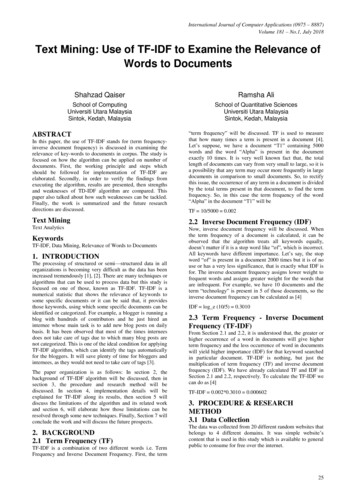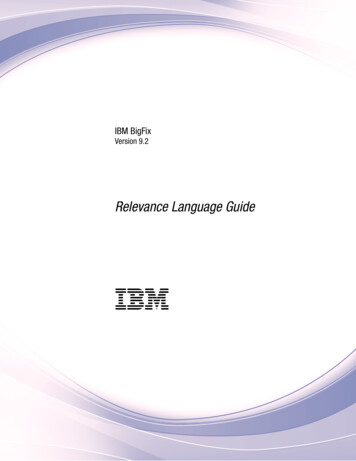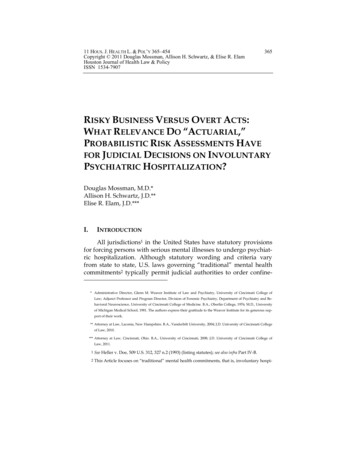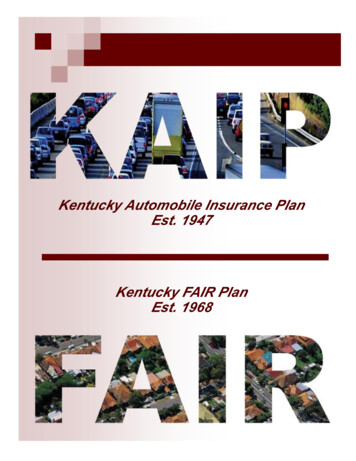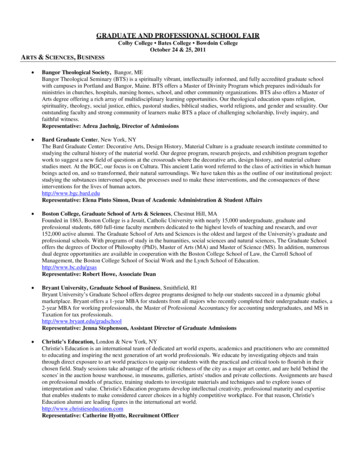
Transcription
International Journal of Economics, Commerce and ManagementUnited KingdomVol. VI, Issue 5, May 2018http://ijecm.co.uk/ISSN 2348 0386VALUE RELEVANCE OF IFRS13 FAIR VALUE HIERARCHYINFORMATION IN PALESTINIAN FINANCIAL INSTITUTIONSGhassan DaasAsst Professor, An-Najah National University, Nablus, Palestinedaas@najah.eduTala JammalMaster of Accounting candidate, Department of Accounting,An-Najah National University, Nablus, Palestinetala.jammal@live.co.ukAbstractThis article aims to investigate whether fair value hierarchy affects value relevance ofPalestinian portfolios, especially level three, due to unobservable inputs use on it. Theresearchers used regression model (logarithm regression) which mainly includes fair valuelevels as independent variables, and stocks price, for those companies have portfolios, as adependent variable. The targeted population is the Palestinian financial organizations (14institutions) that include portfolios under Palestine Exchange (PEX) from period 2011 to 2016which is the most recent period. The article results showed that the fair value hierarchysignificantly affects the relevance and reliability of information presented to the investor's, themark-to-model fair value assets are significantly priced higher than mark-to-market fair valueassets. Finally, level 3 gains do not reduce investors' pricing of Level 3 asset, due to theinvestor's trust in entities’ information, since it is audited and disclosed in the financial reports inaccordance with the requirements of standards.Keywords: Fair value, Fair value hierarchy, level 3, mark-to-market fair value, historical cost,informationLicensed under Creative CommonPage 54
International Journal of Economics, Commerce and Management, United KingdomINTRODUCTIONAccounting measurement is a critical and controversial topic in preparing financial reports. Over80 years ago, intellectuals and researchers adopted various methods to measure the elementsof financial statements; historical cost and fair value were the methods most widely used(Christensen & Nikolaev, 2013, pp.1-2;Majercakova& Skoda, 2015, p.17).Holzman & Robinson (2004, p. 1) found a historical cost which is may be the mostreliable and objective measurement tool; however, not the most relevant one. Landsman (2007,p. 6) pointed out that fair value is more informative if it is compared with historical cost. FASBand IASB have outweighed relevance over reliability which lead boards to issue specialstandards for fair value (Christensen & Nikolaev, 2013, p. 7).Fair value was gradually developed by accounting standard setters. For example,Financial Accounting Standard Board (FASB) was the first to use it through issuing relatedstandards like: SFAS107, SFAS115, and SFAS113 (Jones & Stanwick, 1999, p. 2). InSeptember 2006, the board issued SFAS157 which became a single source for other SFAS thatuse fair value (Board, 2007, p. 5).The International Accounting Standard Board (IASB) proceeded a similar path to FASBin developing fair value by issuing IAS 32, and IAS39 (Jones &Stanwick, 1999, p. 4). In May2012, IASB issued IFRS13 under the title of Fair Value Measurement. One of the mostimportant purposes of IFRS13 is to improve consistency and reduce complexity in fair valueapplications, in addition to enhancing disclosures to enable users of financial reports frommaking decisions. As a result, IASB developed fair value hierarchy. This hierarchy includesthree levels of inputs: level one which depends on quoted prices in an active market; level twowhich depends on inputs other than quoted prices used in level one that are observable forassets and liabilities; and level three which includes unobservable inputs for the assets andliabilities (Picker et al., 2012, pp. 68-69).In 2007, all Palestinian listed companies under Palestine Exchange were required toprepare their financial statements according to IFRS which confirms that PEX are committed totheir vision statement to enhance the secure trading environment, by following the beststandards used all around the world (Abu Dieh, 2015, p. 17).In 2010, The World Bank studied whether the financial reports of 11 Palestinian listedcompanies was compatible with IFRS to find a high degree of compliance with IFRS amongthem (Abu Dieh, 2015, p. 17). Abu Mutair & Alnairab (2012, p. 83) emphasized the importanceof financial information amongst investors and its effect on their decisions. Also, Abu Dieh(2015, p. 76) found that using IFRS enhances accounting information quality.Licensed under Creative CommonPage 55
Daas & JammalIn 2008, Palestinian listed companies used IAS39 Financial Instruments: Recognition andMeasurement, in order to have advantages like: improving user's decision quality, increasingefficiency of financial statements, recording transactions in more effective way, and classifyingfinancial instruments in an organized manner (Al-Helw, 2009, p. 80).Moreover, measuring portfolio by fair value according to IAS 39, lead to the improvementof the financial performance of the majority of Palestinian companies, and enhanced investors'trust (Younis, 2011, p. 110).Thus, this article aims to study whether fair value hierarchy affects value relevance ofmeasuring Palestinian portfolios, especially level three, due to unobservable inputs use on it,and answer the following question: Does fair value hierarchy enhance the information qualitiesin regards of either relevance or reliability (value relevance) used in measuring portfolios underPalestinian financial institutions?Value Relevance of Fair Value HierarchySebastian, Danut, & Maria (2014, p. 308) pointed out that selection of accounting model andrevaluation method were considered as an important reason for the financial crisis, which mainlyhappened in industrial sector, due to meet objectives of stockholders who were concerned overmaximizing the company's equity, its share price and dividend. Indeed, that required a newaccounting model other than historical cost which was the market value or 'fair value'. On theother hand there was other researchers like Alkababji (2016, p.65) who said that using fair valueaccounting was one of the most important reason for the financial crisis in banking sector.Although most companies preferred to use historical cost, they were required to applyfair value to enhance the comparability among companies listed in capital market. Improving thecomparability and consistency of fair value as a measurement and disclosure tool required bothboards to developing the fair value hierarchy which has three levels depend on the type ofinputs, whether it is observable or unobservable. Accordingly, the fair value is a powerfuldisclosure tool as it plays a great role in increase transparency which leads to encourage thecurrent stockholder, potential investors, and other stakeholders because it depicts and explainswhich kind of inputs, assumptions and technical methods were used in the measurement(Majercakova& Skoda, 2015, p. 6).Researchers found out many factors effect on value relevance of fair value hierarchy.For example, Magnan (2009, pp. 200-202) said the market conditions play important role indetermining the relevance and reliability of fair value, even when the market condition is liquidand stable. So, if the market is suffering from lower level of efficiency and high level of illiquidity,the fair value would provide a misleading information, especially if it is based on the input ofLicensed under Creative CommonPage 56
International Journal of Economics, Commerce and Management, United Kingdomlevel 2, and level 3 which requires investors to discount the fair value due to its reliance on otherthan observable inputs and the management's judgment (Goh, Li, Ng, & Yong, 2015, p. 3) AlsoSong, Thomas, & Yai (2010, p. 1404)pointed out that the value relevance of fair value differswith the quality of corporate governance, in other words, when the corporate governance beweak, then the value relevance will be lower than expected especially level 3 will be near nonrelevance, but when corporate governance be strong, then the value relevance will be meet.Both levels have been received attention by both boards and researchers, especiallylevel 3, due to its reliance on firm's estimation which makes it the riskiest level in fair valuehierarchy. Moreover, it usually provides ambiguous results which are hardly to express andinterpret to be able to diagnose the situation of the firm and compare it with other firms. It is alsonot easily verified by the auditors, and usually has high level of information asymmetry andinformation risk (Goh et al., 2015, p. 5).Consequently the FASB and IASB request companies to present additional disclosures,if the input belongs to level 3 (Goh et al., 2015, p. 4). Kolev (2009, p. 1) pointed out that level2and level 3 could reflect the private information which creates a strong set of financialstatements that help investors in making their decisions.Applying International Financial Reporting Standards in PalestineMany researchers investigated the effect of adoption International Financial ReportingStandards (IFRS) on the quality of financial statements in Palestine, such as (Garboua & Heles,2005, p.37), who analyzed and evaluated the using of IFRS in presenting and disclosingfinancial statements in banks and financial institutions, they found out that applying IFRScontributes to reducing the likelihood of problems expected when reviewing the financialstatements and attracting foreign investors. In addition, (Abu Dieh, 2015, p.66-68) made acomparison between pre-adoption period and the post-adoption period, she found the majorityof studied standards enhances quality of financial statements, declines earning management,decreases timely loss recognition and improves value relevance. As well as, (Abu-Sharbeh,2017, p.27) who stressed over the readiness of Palestinian practitioners and academics toaccept IFRS in their jobs. Despite of the required budget for the conversion from US GAAP toIFRS.As for the effect of applying fair value accounting, (Al-Najar, 2013, p.22) made a study ofthe impact of applying fair value accounting (FVA) on the reliability and appropriateness offinancial statements information issued by the Palestinian corporations, he said that theadoption of FVA, increases the value relevance of financial information. Although manychallenges face its application, for example, lack of efficient and active market for most assets,Licensed under Creative CommonPage 57
Daas & Jammala burden budget required to adopt fair value accounting and misinterpretation of financialinformation.In addition, (Al-Kababji, 2016, p.83) studied the extant of compliance with disclosurerequirements for fair value measurement (IFRS 13) in Palestinian corporations, by using adisclosure score called unweighted fair value disclosure index (FVDI), which is the ratio of thevalue of the number of items a company discloses divided by total value that it could disclose.He found out direct relationship between the size of the firm and the level of compliance with thedisclosure requirements for fair value measurement of the firms, no correlation between theprofitability of the firm and the level of compliance and direct relationship between type ofauditor and level of compliance with the disclosure requirements for fair value measurement ofthe firms.RESEARCH METHODOLOGYVarious methodologies have been used through related researches and articles. Barth was oneof the first researchers who adopted the value relevance approach (Barth, Beaver, & Landsman,2000, p. 9) which is based on studding how stocks prices reflect relevance and reliability of fairvalue (Barth, 1994, p. 1). Song et al. (2010, p. 1388), Goh et al., (2015, p. 9) and others wereinterested in studying the relevance value of fair value hierarchy by using the followingmethodology.This regression will be used to test the first hypothesis which aims to investigate the valuerelevance of fair value hierarchy.Pricei, t b0 b1FVA1i, t b2FVA2i, t b3FVA3i, t b4NFVAi, t b5NFVLi, t b6FVL12i, t b7FVL3i, t b8EPSi, t ei, tThe second regression investigates the effect of fair value hierarchy, especially level 3, on stockprice (value relevance):Pricei, t c0 c1FVA1i, t c2FVA2i, t c3FVA3i, t c4NFVLi, t c5FVL12 i, t c6FVL3 i, t c7LVL3GAINS i, t c8LVL3GAINS * FVA3i,t ei, tResearch approachIn this research, the" value relevance" approach is utilized to investigate the value relevance offair value hierarchy, which is adopted by (Barth, 1994, p.1; Francis and Schipper, 1999, 319352). Under this perspective, accounting number is value relevance when it has the influence onstocks' price, otherwise it is not.The researchers has built a hypothetical system contained past researches, hypothesesand discoveries. This system goes into profundity about the idea of value relevance andLicensed under Creative CommonPage 58
International Journal of Economics, Commerce and Management, United Kingdomexamines the part of accounting direction in value relevance investigation. In order to providethe related financial parties (Companies, stockholders, stakeholders and others) with adequateknowledge into the field of value relevance of fair value .To achieve this goal, the researchers chose to collect information from all financialinstitutions listed on Palestine Exchange (PEX). The information gathered includes stock price,earning per share (EPS) and financial information related to fair value hierarchy.Since the fair value hierarchy is the subject of matter, thus the International FinancialReporting Standard (13) "Fair Value Measurement" has to be utilized. To meet the disclosurerequirements, the accompanying least exposures are required for each class of assets andliabilities measured at fair value (counting estimations in view of fair value inside the extent ofIFRS). Take note that these requirements have been summarized in IFRS 13, Paragraph 7
Master of Accounting candidate, Department of Accounting, An-Najah National University, Nablus, Palestine tala.jammal@live.co.uk Abstract This article aims to investigate whether fair value hierarchy affects value relevance of Palestinian portfolios, especially level three, due to unobservable inputs use on it. The researchers used regression model (logarithm regression) which mainly includes .
